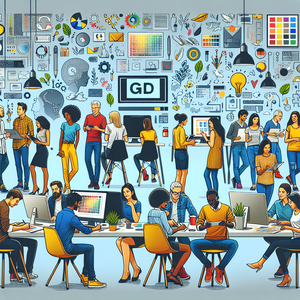From Hobbyist to Professional: Navigating the Transition in Graphic Design

The first step in transitioning from hobbyist to professional is recognizing that graphic design is not just a pastime but a legitimate career path. This requires a fundamental shift in mindset. Embrace the reality that pursuing graphic design as a profession involves commitment, ongoing learning, and an entrepreneurial spirit.
Identify Your Niche
One of the most critical elements of becoming a professional graphic designer is identifying your niche. Graphic design is an expansive field that includes specialties like branding, web design, user experience (UX) design, and illustration. Reflect on your interests and strengths. For example, if you have a flair for creating eye-catching advertisements, you might focus on marketing design. By specializing, you can create a compelling portfolio that speaks to your target audience and positions you as an expert in that area.
Develop Essential Skills
While hobbyists may have a basic understanding of design principles, professionals need a robust skill set. Familiarize yourself with industry-standard tools such as Adobe Creative Suite, Sketch, or Figma. Moreover, understanding fundamental design concepts—like typography, color theory, and layout—is crucial. Online learning platforms like Skillshare, Coursera, and Udemy offer extensive courses tailored to graphic design that can help you advance your technical skills and stay current with industry trends.
Build a Strong Portfolio
Your portfolio is your most powerful marketing tool. It should not only display your best work but also reflect your personal style and versatility. Include a variety of projects that represent different aspects of your skill set. If you're just starting, consider creating speculative designs or volunteering your services to local businesses or non-profits. This not only enriches your portfolio but also allows you to gain practical experience and client testimonials that will be invaluable when seeking paid work.
Networking and Building Relationships
Networking is a cornerstone of a successful freelance career. Attend design conferences, local meetups, and workshops to connect with other professionals and potential clients. Additionally, engaging with online design communities—such as Behance, Dribbble, and LinkedIn—can broaden your network and expose you to collaboration opportunities. Building relationships is essential; it could lead to referrals and constructive feedback, both of which are vital for growth.
Market Yourself Effectively
Self-promotion is integral to establishing a successful graphic design career. Develop a personal brand that encapsulates your unique style and expertise. Utilize social media platforms such as Instagram and Pinterest to showcase your designs and engage with your audience. Consider writing a design blog or creating video content to share your insights and processes, which can position you as a thought leader in the field. An updated website acts as a central hub for your portfolio, contact information, and the services you offer.
Embrace a Freelance Mindset
Transitioning to freelance work comes with its own set of challenges. Understand the business aspects of design, including client management, invoicing, and legal contracts. Set clear boundaries regarding work hours and rates, and be prepared to negotiate. Embracing a freelance mindset means recognizing that you are not just a designer but also a business owner, responsible for both creative and administrative tasks.
The transition from hobbyist to professional graphic designer is a journey filled with excitement and challenges. By identifying your niche, honing essential skills, building a strong portfolio, networking effectively, marketing yourself, and adopting a freelance mindset, you can successfully navigate this transition. Remember that every professional was once a beginner, and with determination and strategic planning, your passion for graphic design can flourish into a rewarding career. Whether you dream of collaborating with high-profile clients or making a difference with local businesses, the opportunities are boundless for those prepared to take the leap. Embrace the challenge and let your creativity and individuality shine in the dynamic world of graphic design.
Branding Designer
Advertising agencies, branding firms, and corporate marketing departments.
Core Responsibilities
Develop and maintain brand identities for clients, including logos, color palettes, and typography.
Conduct market research to understand target audiences and create brand strategies that resonate.
Collaborate with marketing teams to ensure brand consistency across all platforms and materials.
Required Skills
Proficiency in Adobe Illustrator, Photoshop, and InDesign.
Strong understanding of branding principles and consumer psychology.
Excellent communication skills for presenting ideas and concepts to clients.
User Experience (UX) Designer
Technology companies, app development firms, and e-commerce platforms.
Core Responsibilities
Conduct user research and usability testing to gather insights about user behavior and preferences.
Create wireframes, prototypes, and user flows to design intuitive interfaces.
Collaborate with developers and product managers to implement design solutions that enhance user satisfaction.
Required Skills
Expertise in design tools like Sketch, Figma, and Adobe XD.
Strong analytical skills to interpret user data and feedback.
Knowledge of HTML/CSS is a plus for better collaboration with development teams.
Web Designer
Digital marketing agencies, freelance clients, and tech startups.
Core Responsibilities
Design and implement visually appealing and user-friendly websites tailored to client specifications.
Optimize website layouts for various devices and browsers, ensuring responsive design.
Work closely with content creators to integrate multimedia elements effectively.
Required Skills
Proficiency in HTML, CSS, and JavaScript for basic web development.
Familiarity with CMS platforms like WordPress or Shopify.
Strong understanding of SEO principles to enhance website visibility.
Motion Graphics Designer
Film production companies, advertising agencies, and media organizations.
Core Responsibilities
Create engaging animations and visual effects for video content, advertisements, and presentations.
Collaborate with directors and editors to ensure animations align with the overall vision of the project.
Stay updated on industry trends and incorporate new techniques into design processes.
Required Skills
Proficiency in software such as After Effects, Cinema 4D, and Premiere Pro.
Strong storytelling skills to convey messages through motion.
Ability to work under tight deadlines while maintaining high-quality standards.
Print Designer
Print shops, marketing firms, and corporate communication departments.
Core Responsibilities
Design print materials such as brochures, posters, and packaging that effectively communicate brand messages.
Collaborate with clients to understand their vision and deliver creative solutions that meet their needs.
Manage the production process, ensuring high-quality output and adherence to timelines.
Required Skills
Expertise in Adobe Creative Suite, particularly InDesign, Photoshop, and Illustrator.
Strong understanding of print production processes and materials.
Excellent attention to detail to ensure accuracy in designs.


